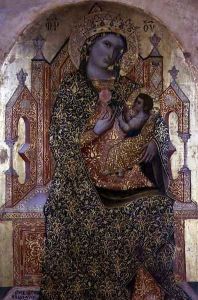Stefano Veneziano Paintings
Stefano Veneziano, also known as Stefano da Venezia, was an Italian painter who was active during the mid-14th century, a period that marked the transition from Byzantine art to the more naturalistic styles of the Renaissance. Little is known about his life, and the precise dates of his birth and death are not documented. He is first mentioned in historical records in the 1350s, and his work suggests that he was a product of the Venetian school, which was heavily influenced by Byzantine traditions, given Venice's close trade and cultural relationships with Byzantium.
Stefano Veneziano's style is characterized by a blend of the Byzantine iconographic models with the emerging Gothic sensibility of the time, which included a greater emphasis on naturalism and the depiction of volume and space. His figures often exhibit a grace and tenderness that were becoming increasingly popular in the Gothic art of Western Europe. One of his most renowned works is the 'Madonna dell'Itria,' a Virgin Hodegetria type of icon, which was painted for the church of San Antonio di Castello in Venice.
Despite the scarcity of biographical details, Stefano Veneziano's influence in the Venetian art scene is evident. He is considered one of the precursors to the great flowering of Venetian painting that would occur in the later 15th and 16th centuries, heralding artists like Giovanni Bellini and Titian. His last known work dates from 1378, and it is presumed that he died sometime after this date. As with many artists of the period, his legacy is primarily understood through the artworks he left behind, which contribute to our understanding of the development of Venetian art during a pivotal era in European art history.
